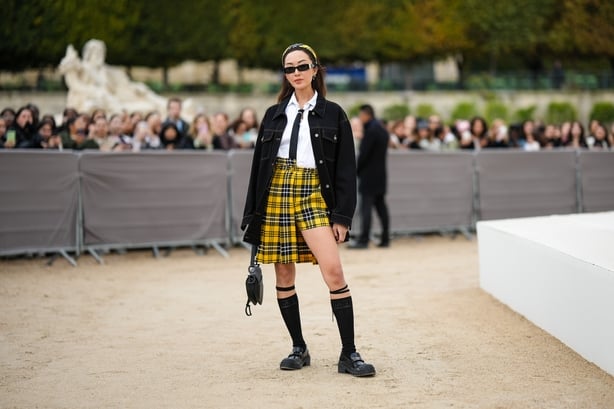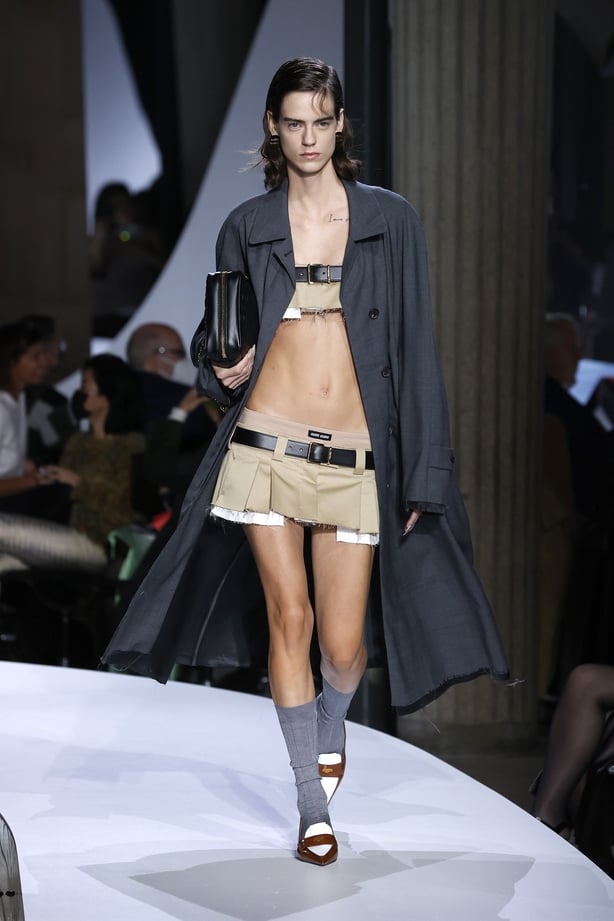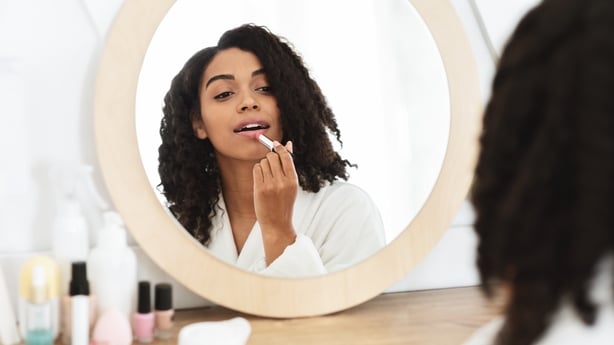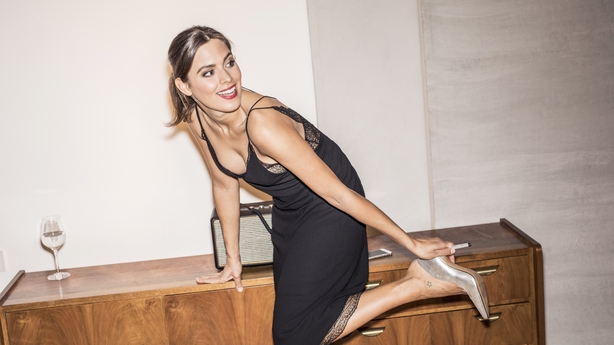Sarah Magliocco writes about the fashion trends that experts believe are warning signs of recession.
Are we heading for a recession? Both economic and fashion experts believe we might be.
Forbes predicts the recession will begin in late 2023 or early 2024, and according to KPMG's latest CEO survey, 86% of top executives reckon there will be a recession in the next 12 months, though almost 60% think it will be mild.
We knew that certain trappings of the year 2008 were coming back in vogue - the return to favour of digital cameras and hipster fashion being notable mentions. However, if we truly are due a little dip in economic prowess, history dictates that there are certain style elements we will see scuttling back around the sartorial cycle once more.
Some economists have argued that the health of the economy can be measured by certain fashion trends, as our money anxieties creep into the sartorial choices we make.
The looming recession is hailing in a new era of fashion, and while the experts postulate on our propensity for austerity, we're looking at how it may hypothetically impact our wardrobes and wallets.
The Hemline Index

The Hemline Index is a theory that the length of skirts and dresses follows the pattern of the rise and fall of the economy. When times are good, skirts are short, and when there are deteriorations to the world's financial status, they dip back down.
This theory is a little skewed as the popularity of long skirts has waned significantly in contemporary fashion, but it could be seen prominently in the 1920s and 1960s, particularly in the USA as the stock market rose and fell.
The 1950s is the outlier, as longer skirts symbolised the demure aesthetics of a wealthy suburban housewife.

There is very little research on the matter, but one 2010 study suggests that hemlines are a predictor of the economy and run about three years ahead of the world’s fiscal status. If short skirts are the symbol of good times, you would think we should be in for a boom, with the Miu Miu mini-skirt being the most talked about item in fashion in 2022.
Perhaps the pandemic is biassing the theory, as people want to be exploratory with their fashion choices after a long stretch of comfort clothing. However, longer skirts are also a trend at the moment, as seen in the rise in popularity of longer, utilitarian cargo skirts and low-waisted, 90s style, straight-cut long skirts.
Revolutionary movements such as feminism, environmentalism and the civil rights movement all had an impact at this time too, with hemlines rising as an act of rebellion against previous generations.
The Lipstick Index

The so-called Lipstick Index refers to an observational phenomenon that consumers will still tend to buy small luxury items even during an economic downturn. It's like allowing yourself a "little treat" while on a diet, or having one glass of wine at home instead of going out on the town.
The idea was first speculated upon by economics and sociology Professor Juliet Schor. In her 1998 book The Overspent American, she considered the idea that people spend money on small symbols of status like a designer lipstick or compact that can be used in public and give a small thrill of luxury without being detrimental to your bank account.
That idea was pushed into public consciousness in 2011 by Leonard Lauder, chairman of Estee Lauder, who reported his company experienced an increase in lipstick sales after the 9/11 terrorist attacks and again in the worldwide recession of 2008.
While lipstick in a traditional sense is a classic addition to any makeup bag, the 2022 version of a tube of bright lippy might be the coveted Dior lip oils, which went viral on TikTok and became a symbol of the trendy 'clean girl aesthetic’ across social media.
At €40 they are far from cheap compared to their dupes which hover around the 10 quid range, but it’s an achievable aspiration which may offer a frisson of consumer gratification while times are tough. However, this could be applied to cosmetics across the board, as lipstick is not the only avenue through which people can get this buzz of luxury shopping without a large price tag.
Heel height theory

Much like hemlines, heel height has gone up and down in response to the economic cycle, with over 100 years of shoe trends that back up the connection between statement footwear and impending financial crisis. People use flamboyant fashion as a means of escapism during times of economic strife, and skyscraper heels are part of that fantasy.
After World War 1 in the 1920s, frugality was the name of the game, but that didn't stop people from enjoying themselves as best they could with more freedom in fashion. With the rise in hemlines, shoes became an accessory for women for the first time, and heels were part of that. Comfortable strapped pumps were the most popular footwear for women, and had heel heights of about two inches.
By the 1930s, with the Great Depression in effect, women’s clothing became more dour, leaving the flapper style behind, but shoes kept increasing in height as making shoes more decorative was affordable and didn’t use too many materials.
Salvatore Ferragamo is credited with introducing the platform shoe in the late 1930s with his rainbow-hued gold-strapped platform sandal, the original of which currently sits in The Costume Institute at The Met Gala in New York City, while a modern replica of the style is still sold by the fashion house to this day.
Meanwhile, the 1970s oil crisis was making the cost-of-living rise, and people had less cash on hand than in the 1950s. For one of the first times in the last century, heels and platforms were embraced by people of all genders, with the 1970s being one of the greatest, most experimental times for fashion in recent history.
In the 1980s and 1990s, the economy was improving and more women than ever before joined the workforce. For this reason, heels lowered once more to accommodate a 9-5 schedule that might include walking or getting public transport to and from work.

Platforms rose once again in the late 1990s, as the internet valuable bubble burst and Spice Girls stepped in to offer us pure escapism.
By the time the recession hit in 2008, there was a huge increase in searches for high heeled platform shoes, like the now iconic and once-highly coveted Jeffrey Campbell 'Lita’ boot, which was popularised by social media sites like Tumblr and Pinterest.
Social media platforms platforming platforms, if you will.
As the 2010s made way for the 20-teens, casual footwear in the form of Vans runners, Nike Airmaxes and New Balance ‘Dad sneakers’ were on trend as the economy remained stable.
So where does that leave us? With Y2K style the dominant trend and the global financial system scheduled to nosedive once more, platforms are back.
As the pandemic came to a close, Versace’s Medusa Aevitas platform heels were the most popular shoe style, with dupes cropping up across the high street and online, a tantalising treat for us to add to our outfits after a terrible stretch of house slippers and beat up runners for our 2km walks.
Google Trend data for the past five years shows a huge spike in searches for platform heels at the beginning of 2022, after a bit of a lull during the pandemic. Comfort is being manoeuvred out of the way in favour of style once more, and with fast fashion firmly at the forefront of most shopper’s minds, these statement looks will remain achievable even if inflation keeps rising and people struggle in other areas.
Normcore
Historically it has been considered tacky and uncouth to excessively showcase your wealth in times of global or community-wide economic stress, and minimalism was one of the biggest trends to emerge following the 2008 recession.
Basics were big during the pandemic days, with plain slacks, t-shirts and comfortable jumpers being bought en-masse for the adjustment of working from home in comfort while still maintaining a semblance of professionalism - on the top half at least - for those Zoom meetings.
The previously mentioned "clean girl aesthetic" is leading the charge returning to a more pared-back look, repurposing those matching loungewear sets and casual but tailored trousers into a whole new style dynasty. It’s an antidote to the hyper-trendy Avant-basic style that reigned supreme through 2020 and 2021, and while the "clean girl aesthetic" is a champion of normcore, it can be done in an edgy and contemporary way too.
As sustainability has become more important to consumers, particularly millennials and Gen Z, there is a drive to repurpose items, leading this wave of normcore to lean towards the 90s as vintage basics like knee-high black boots, plain denim mini skirts and leather blazers of all shades are considered staples of a cool but understated new look.
Look to the likes of Verona Farrell’s (@SecondHandHun) Instagram videos of what people are wearing in Sweden and New York for inspiration, or to influencer Matilda Djerf, who has been a stylish but understated it-girl for years now thanks to her revolving wardrobe of oversized blazers, carefully chosen denims and sexy but simple dresses and silhouettes.


